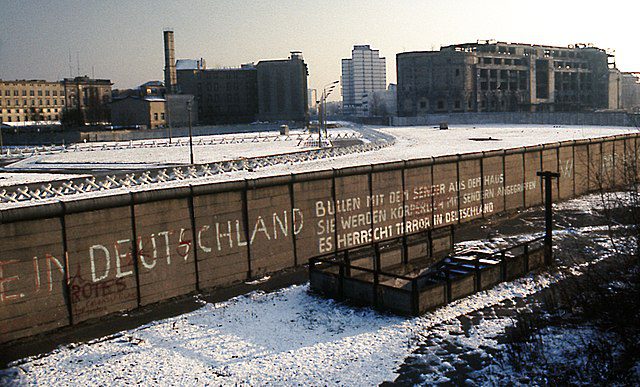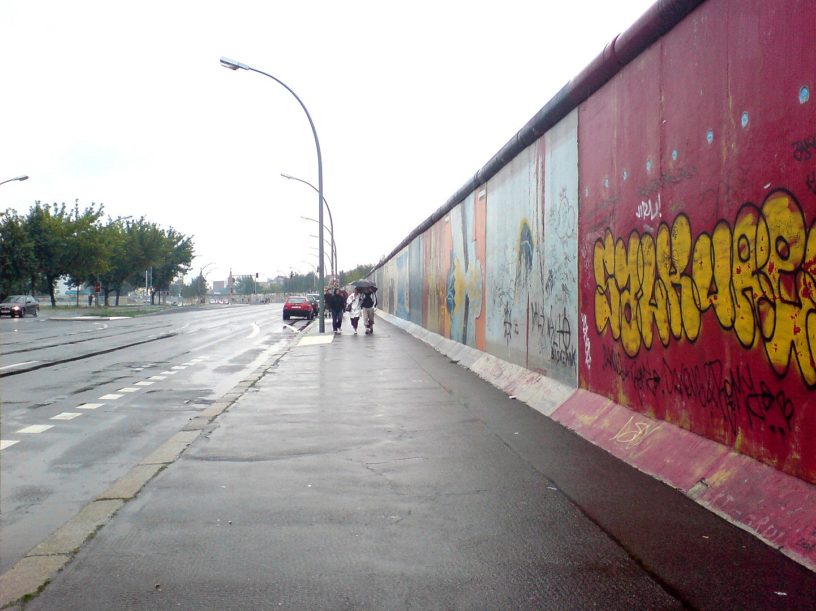
Photo by Emile Guillemot on Unsplash
Top 15 Facts about the Berlin Wall
Originally published by Lilian on April 2020 and updated by Charity K on August 2022
The Berlin Wall separated East and West Berlin for 28 years. The wall symbolized division and control.
The wall was built in 1961 and was brought down in 1989, it cut off East and West Berlin and East Germany. There were guards posted at the wall to prevent people from crossing.
Before the Wall was built, people on both sides were able to move freely to and from each side. This slowly began to change even in the transport system that ferried passengers back and forth.
The wall was built without prior warning and it led to a scuffle as people tried to cross to either be on the right side of the wall or be with family.
The Berlin Wall separated families and rendered others jobless especially the East Berliners. The West weren’t happy either and protested against the construction of the wall.
Here are the top 10 facts about the Berlin Wall.
1. The wall was built after World War II
The conferences held at Yalta and Potsdam were the two most important peace conferences of World War II.
It was after this conference that the Berlin Wall was built after a settlement made. Those in attendance agreed to divide Germany int four.
Those four regions were occupied by the United States, United Kingdom, France and the former USSR.
Berlin, which was inside the Soviet region, had been likewise divided.
Up until 1961, people would regularly pass from East Germany to West Germany.
It is estimated that almost 3.5 million people fled East Germany into West Germany. At least 1,000 were crossing over in a day by 1961.
Nikita Khrushchev, who gave the orders to erect the wall, did so to stop the expatriation of workers.
2. The wall initially consisted of barbed wires and concrete blocks

Photo by Jaron Mobley on Unsplash
The plan to have the wall put up was abrupt. Berliners woke up to find a barrier made up of coiled barbed wires and concrete blocks.
The construction of the wall began on August 12-13 in 1961. The wall was 96 miles (154.5 km) long stood between 115 and 15 feet (4.57 meters) tall.
Between the two walls that were built, was a 160-foot death strip.
There were 302 watchtowers, 20 bunkers, 55,000 land mines, 259 dog runs, and machine guns that were activated by tripwires.
When the wall was first built, only those with genuine documents were allowed to cross at the checkpoints.
3. Hundreds died while crossing the wall

By Victorgrigas wikimedia
People lost their lives while attempting to cross the wall. At least 300 people died while crossing from Berlin Wall to West Germany a few of whom were women.
Those that did not make it across were captured or shot dead. 5000 people got captured and at least 138 were shot.
Others died from fatal falls through suicide after failed escape attempts. The first recorded death after a fall was Ida Siekmann on August 22, 1961. She had attempted to jump from her fourth-floor in East Berlin to West Berlin.
4. There was no government order to bring down the wall
On November 9th 1989, Günter Schabowski who was the government spokesman is said to have read his notes wrongly during a press conference.
In his speech he mentioned that the government allowed Germans on the East to cross into the West immediately without delay.
The announcements were meant for the next morning and those allowed to cross over were required to apply for a travel visa.
The guards at the border were overwhelmed and with no orders on what to do, opened the barriers and People who were eager to cross were soon streaming into West Berlin.
5. The Berlin Wall was compared to the stringent U.S immigration policy
Factions that sided with the Communists and the Soviets during the Cold War, compared the Berlin Wall to the U.S immigration policy.
When the then U.S President Ronald Reagan visited Berlin in 1982, he was quoted saying that the wall was not made of iron to keep people out but in. He later referred to the wall as a grim monument of repression at a United Nations meeting.
In 1987, president Reagan in his speech at the Brandenburg Gate demanded the wall to be destroyed.
6. Berlin Wall was brought down by any tool including bare hands

By Max Ronnersjö wikimedia
After the press conference by Günter Schabowski, excited and jubilant crowds went to the wall and tore it down using the closest tool they could lay their hands on.
They used shovels, sledgehammers, hammers, and their bare hands. Once the wall was brought down thousands of people from the East crossed over to West Berlin.
At least two million people visited West Berlin that weekend to be part of a celebration by the streets.
7. Many people dug their way out of the wall
People who crossed the wall from the East to the West were seen as defectors. The first person that successfully escaped was a 19-year-old Corporal Conrad Schumann, a guard at the East German border.
The corporal jumped over a 3-foot high barbed-wire wall two days after East Germany closed the border.
Other people desperate to flees the Eastside, devised methods to secretly cross over. Some hid in secret car compartments, some dug tunnels while others crawled through sewers.
Three brothers are remembered for some of the most genius escapes; one used an inflatable mattress across the river, the other crossed over in a steel cable that he fired with a bow and arrow and later the two elder brothers went to rescue their younger brother in an ultra-light plane.
8. East Germany had a name for the Wall
The East German government claimed that the wall was built to keep away western fascists and spies.
After the wall was built, the East German leader Walter Ulbricht said the wall sealed off the cracks in the fabric of their houses, that it closed the holes used by their worst enemies to creep into Germany.
They named the wall, “Antifaschistischer Schutzwall.”
9. The Berlin Wall was built to keep people in
The Berlin Wall intended to keep the people in especially in East Berlin. It was constructed and guarded to stop Germans from going to the west to work.
East Germany ensured that they had their military stationed at the entire border with the West. They had one million land mines and more than 3,000 guard dogs.
10. Two walls made up the Berlin Wall
So we only hear of the Berlin Wall not the Walls. Well, there were two walls built across each other.
The 27-mile-long concrete wall divided Berlin into East and West. In between the walls was a portion of land called the Berlin Wall death strip or no man’s land.
On this strip, the guards were allowed to shoot anyone attempting an escape.
The Berlin Wall was used to symbolize the Cold War and manifest what they called the iron curtain separating democracy and communism.
11. Both German States benefitted from the creation of the wall

Photo by Edward Valachovic – Wikimedia
The creation of the Wall had important implications for both German states. By stemming the exodus of people from East Germany, the East German government was able to reassert its control over the country.
However, in spite of discontent with the Wall, economic problems caused by dual currency and the black market were largely eliminated. The economy in the GDR began to grow.
In addition, the Wall proved a public relations disaster for the communist bloc as a whole. Western powers portrayed it as a symbol of communist tyranny, particularly after East German border guards shot and killed would-be defectors. Such fatalities were later treated as acts of murder by the reunified Germany.
12. Political Activitist apprehended

Photo by Jim Garamone – Wikimedia
In 1986, defector and political activist Wolfram Hasch and four other defectors were standing inside the outer strip defacing the wall when East German personnel emerged from one of the hidden doors to apprehend them.
All but Hasch escaped back into the western sector. Hasch himself was arrested, dragged through the door into the death strip, and later convicted of illegally crossing the de jure border outside the wall. Graffiti artist Thierry Noir has reported having often been pursued there by East German soldiers.
While some graffiti artists were chased off the outer strip, others, such as Keith Haring, were seemingly tolerated.
13. The nine crossing at the border between East and West Berlin

Photo by Wikimedia Commons – Wikimedia
There were nine border crossings between East and West Berlin. These allowed visits by West Berliners, other West Germans, Western foreigners, and Allied personnel into East Berlin, as well as visits by GDR citizens and citizens of other socialist countries into West Berlin, provided that they held the necessary permits.
These crossings were restricted according to which nationality was allowed to use it, for instance, East Germans, West Germans, West Berliners, and other countries. The best known was the vehicle and pedestrian checkpoint at the corner of Friedrichstraße and Zimmerstraße at Checkpoint Charlie, which was restricted to Allied personnel and foreigners.
Several other border crossings existed between West Berlin and surrounding East Germany. These could be used for transit between West Germany and West Berlin, for visits by West Berliners into East Germany, for transit into countries neighboring East Germany (Poland, Czechoslovakia, Denmark and for visits by East Germans into West Berlin carrying a permit.
After the 1972 agreements, new crossings were opened to allow West Berlin waste to be transported into East German dumps, as well as some crossings for access to West Berlin’s exclaves.
14. The unique connection between west Berling and West Germany

Photo by Wikimedia Commons – Wikimedia
Four autobahns connected West Berlin to West Germany, including the Berlin-Helmstedt autobahn, which entered East German territory between the towns of Helmstedt and Marienborn with Checkpoint Alpha, and which entered West Berlin at Dreilinden with checkpoint Bravo for the Allied forces in southwestern Berlin.
Access to West Berlin was also possible by railway (four routes) and by boat for commercial shipping via canals and rivers.
15. The Eastern part was accessible by non-German Westerners
Non-German Westerners could cross the border at Friedrichstraße station in East Berlin and at Checkpoint Charlie. When the Wall was erected, Berlin’s complex public transit networks, the S-Bahn and U-Bahn, were divided with it.
Some lines were cut in half; many stations were shut down. Three western lines traveled through brief sections of East Berlin territory, passing through eastern stations (called Geisterbahnhöfe, or ghost stations) without stopping.
Both the eastern and western networks converged at Friedrichstraße, which became a major crossing point for those (mostly Westerners) with permission to cross.
Planning a trip to Paris ? Get ready !
These are Amazon’s best-selling travel products that you may need for coming to Paris.
Bookstore
- The best travel book : Rick Steves – Paris 2023 – Learn more here
- Fodor’s Paris 2024 – Learn more here
Travel Gear
- Venture Pal Lightweight Backpack – Learn more here
- Samsonite Winfield 2 28″ Luggage – Learn more here
- Swig Savvy’s Stainless Steel Insulated Water Bottle – Learn more here
Check Amazon’s best-seller list for the most popular travel accessories. We sometimes read this list just to find out what new travel products people are buying.









